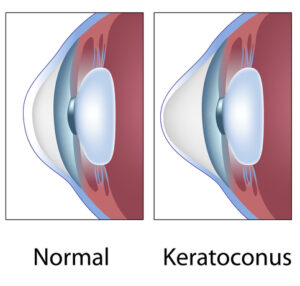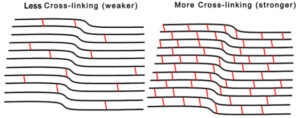Corneal cross-linking is the only known treatment to slow or prevent keratoconus from advancing. Keep reading to learn more about keratoconus and how corneal cross-linking treats this eye condition.
What is Keratoconus?

A healthy cornea has a round shape like that of a basketball. Collagen fiber cross-links maintain their shape.
When you have keratoconus, your cornea lacks adequate collagen fiber cross-links. Insufficient cross-links cause the cornea to grow thinner and weaker. Due to this, the cornea starts bulging and becomes more cone-like in shape.
The cornea, the transparent front part of the eye, helps focus light on the retina, allowing you to see clearly. But in keratoconus, your cornea can’t focus light as it should, leading to blurred, distorted vision.
Keratoconus is a progressive eye condition that causes vision problems and, eventually, vision loss without treatment. It usually develops in both eyes and may affect one eye more than the other.
Often, keratoconus starts to develop in your teens or early 20s. It progresses over 10 to 20 years in most patients and then stabilizes, but there is often considerable vision impairment at that point.
The actual cause of keratoconus is unknown, although it’s thought that genetics are involved. That means keratoconus may get passed down through families.
The following can also increase your risk of keratoconus:
- Excessive eye rubbing
- Inflammation from asthma or allergies
- Ectasia – a complication of LASIK
- Certain conditions like Ehlers-Danlos syndrome, Down syndrome, and retinitis pigmentosa
Signs of Keratoconus

Some of the symptoms of keratoconus include:
- Blurred, distorted vision, even with glasses or contacts
- Rapid changes in glasses or contact lens prescription
- Seeing halos
- Experiencing eyestrain
- Light sensitivity
- Nearsightedness
- Astigmatism
- Excessive eye rubbing
- Poor night vision
- Abrupt vision change in one eye
- Difficulty wearing contacts as the condition progresses
Keratoconus Treatment
Keratoconus treatment aims to slow the condition’s progression and offer the best possible vision correction. Corneal cross-linking is the only treatment capable of slowing the progression of keratoconus.
Corneal Cross-Linking

Corneal cross-linking can’t reverse any changes to vision that have already happened due to keratoconus. But it can halt or slow further changes to the cornea, preventing your vision from worsening.
Corneal cross-linking is most effective when done early in the condition’s progression. Because of this, prompt diagnosis is crucial.
There are two forms of corneal cross-linking: epithelium-off and epithelium-on. Epithelium-off crosslinking has been approved by the FDA, while epithelium-on crosslinking has not yet been approved. At Evergreen Eye Center, we only offer patients epithelium-off corneal cross-linking.
Epithelium-Off Corneal Cross-linking
Epi-off or epithelium-off cross-linking, as the name implies, involves the removal of the epithelium. The epithelium is the surface layer of your cornea.
Removal of the epithelium allows better penetration of the riboflavin solution that is used during the procedure. This enhances the effectiveness of the procedure. The downside of removing the epithelium is that it usually takes 5-7 days for the epithelium heal and there is usually some discomfort and blurred vision during this time.
What to Expect During Corneal Cross-Linking
Before having a corneal cross-linking procedure, you’ll undergo an eye exam to evaluate your vision and overall health at Evergreen Eye Center. Your ophthalmologist will also measure your corneal thickness and shape to determine if corneal cross-linking is right for you.
You’ll sit comfortably in a reclining position on the treatment chair during the procedure. You’ll have your eye kept open using a special instrument to prevent blinking.
Next, your ophthalmologist will apply numbing drops to ensure the procedure is painless. They may also give you a mild sedative to keep you relaxed.
You’ll then have the epithelial layer removed before having Vitamin B2 or riboflavin drops applied. After removing the epithelium, the drops can deeply penetrate the underlying corneal tissue.
They will continue adding the eye drops every few minutes until your cornea is saturated.Once completed, your cornea will be exposed to UV light for about 30 minutes.
The light activates the riboflavin. In turn, the riboflavin forms new bonds called cross-links between the weak collagen fibers in your cornea, making them thicker and much stronger.
Cross-linking your collagen fibers stiffens and strengthens your cornea.
Strengthening your cornea has the following benefits:
- Slows or prevents keratoconus from worsening
- It helps prevent future vision changes or loss
- It sometimes makes it easier to wear contact lenses
- Aids in preventing the need for corneal transplant surgery
After your procedure, your eye doctor will place a contact lens that acts as a bandage over the treated eye. The bandage contact lens helps your eye heal faster and reduces potential discomfort.
Corneal cross-linking takes about an hour to complete. You’ll remain awake and go home shortly after the procedure is over.
Recovery from Corneal Cross-Linking
After your corneal cross-linking procedure at Evergreen Eye Center, your ophthalmologist will prescribe anti-inflammatory and antibiotic eye drops to use at home. You may experience discomfort in the treated eye for about 3 to 5 days.
Some patients describe this discomfort as a foreign body or burning sensation. The level of discomfort varies from person to person.
You can take prescribed painkillers to relieve the discomfort. Cool compresses can also help with discomfort. You may also experience increased sensitivity to light. You can minimize light sensitivity by wearing sunglasses.
You’ll need to schedule a follow-up appointment with your eye doctor, usually the day after your procedure. You’ll typically have the bandage contact lens removed by your ophthalmologist after a week.
Most patients can resume their usual regular routine within one week of having corneal cross-linking.
Good Candidates for Corneal Cross-Linking
You may be a suitable candidate for corneal cross-linking if:
- You have mild to moderate keratoconus
- You have no corneal scarring
- Your vision is not significantly compromised
- You have a cornea that’s not too irregular in shape
Corneal Cross-Linking at Evergreen Eye Center
Evergreen Eye Center is pleased to offer corneal cross-linking to our patients. Our expert team has successfully treated keratoconus using corneal cross-linking and helped many patients achieve their best possible vision.
Are you looking to slow or stop the progression of keratoconus? Schedule your appointment today at Evergreen Eye Center to find out if you’re a suitable candidate for corneal cross-linking.

